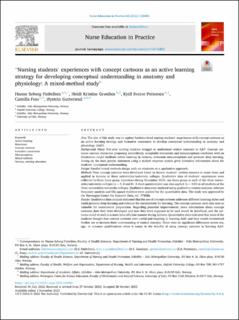| dc.contributor.author | Finbråten, Hanne Søberg | |
| dc.contributor.author | Grønlien, Heidi Kristine | |
| dc.contributor.author | Pettersen, Kjell Sverre | |
| dc.contributor.author | Foss, Camilla | |
| dc.contributor.author | Guttersrud, Øystein | |
| dc.date.accessioned | 2023-02-08T12:09:31Z | |
| dc.date.available | 2023-02-08T12:09:31Z | |
| dc.date.created | 2022-12-05T12:54:44Z | |
| dc.date.issued | 2022 | |
| dc.identifier.citation | Nurse Education in Practice. 2022, 65, Artikkel 103493. | en_US |
| dc.identifier.issn | 1471-5953 | |
| dc.identifier.uri | https://hdl.handle.net/11250/3049262 | |
| dc.description.abstract | Aim: The aim of this study was to explore bachelor-level nursing students’ experiences with concept cartoons as an active learning strategy and formative assessment to develop conceptual understanding in anatomy and physiology (A&P).
Background: Many first-year nursing students struggle to understand central concepts in A&P. Concept cartoons–cartoon characters proposing scientifically acceptable statements and misconceptions combined with an illustration–might facilitate active learning in lectures, overcome misconceptions and promote deep learning. Voting on the most precise statement using a student response system gives formative information about the students’ conceptual understanding.
Design: Parallel mixed methods design with an emphasis on a qualitative approach.
Methods: Nine concept cartoons were developed based on former students’ written answers to exam items and applied in lectures at three universities/university colleges. Qualitative data of students’ experiences were collected in three focus group interviews during November 2019, one focus group at each of the three universities/university colleges (n = 5, 8 and 8). A short questionnaire was also applied (n = 343) to all students at the three universities/university colleges. Qualitative data were analysed using qualitative content analyses, whereas frequency analysis and Chi-square statistics were applied for the quantitative data. The study was approved by the Norwegian Centre for Research Data, ref. 779586.
Results: Qualitative data analysis indicated that the use of concept cartoons addresses different learning styles and could promote deep learning and enhance the environment for learning. The concept cartoons were also seen as valuable for examination preparation. Regarding potential improvements, more information about concept cartoons, how they were developed and how they were supposed to be used would be beneficial, and the cartoons could be used in a more time-efficient manner during lectures. Quantitative data indicated that most of the students thought that concept cartoons were useful and inspiring in learning A&P, and they would recommend further use to increase their understanding of central concepts. There were no significant differences across sex, age, or entrance qualifications when it comes to the benefits of using concept cartoons in learning A&P. | en_US |
| dc.language.iso | eng | en_US |
| dc.publisher | Elsevier | en_US |
| dc.rights | Navngivelse 4.0 Internasjonal | * |
| dc.rights.uri | http://creativecommons.org/licenses/by/4.0/deed.no | * |
| dc.subject | active learning | en_US |
| dc.subject | bioscience | en_US |
| dc.subject | concept cartoons | en_US |
| dc.subject | formative assessment | en_US |
| dc.subject | misconceptions | en_US |
| dc.subject | mixed methods | en_US |
| dc.subject | Norway | en_US |
| dc.subject | nursing education | en_US |
| dc.title | Nursing students’ experiences with concept cartoons as an active learning strategy for developing conceptual understanding in anatomy and physiology: A mixed-method study | en_US |
| dc.type | Peer reviewed | en_US |
| dc.type | Journal article | en_US |
| dc.description.version | publishedVersion | en_US |
| dc.rights.holder | © 2022 The Author(s). | en_US |
| dc.subject.nsi | VDP::Medisinske Fag: 700::Helsefag: 800::Sykepleievitenskap: 808 | en_US |
| dc.source.volume | 65 | en_US |
| dc.source.journal | Nurse Education in Practice | en_US |
| dc.identifier.doi | 10.1016/j.nepr.2022.103493 | |
| dc.identifier.cristin | 2088743 | |
| dc.source.articlenumber | 103493 | en_US |
| cristin.ispublished | true | |
| cristin.fulltext | original | |
| cristin.qualitycode | 1 | |

